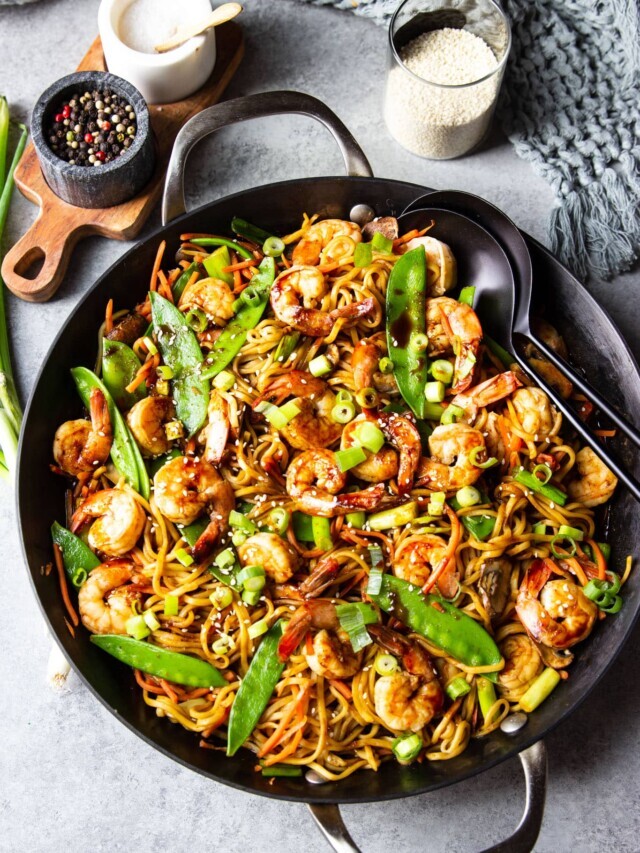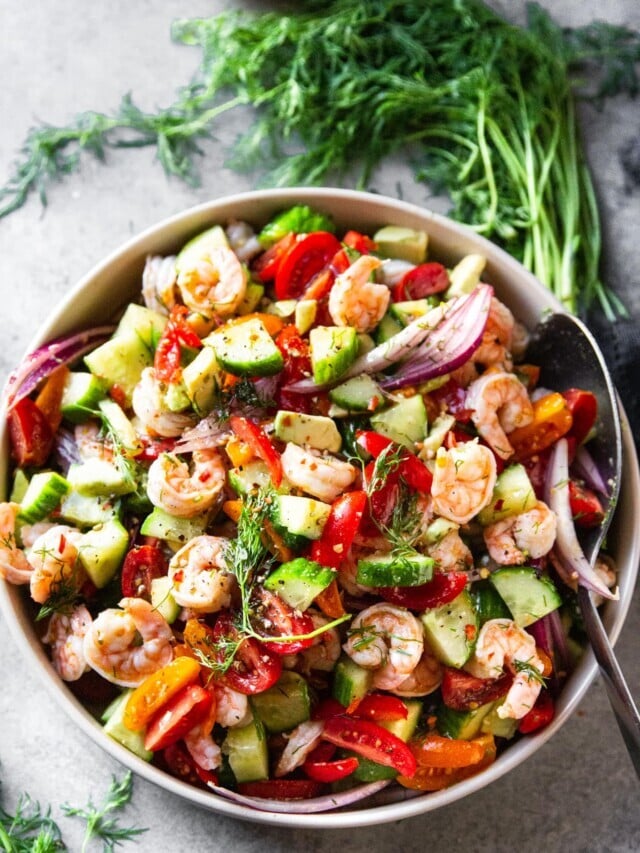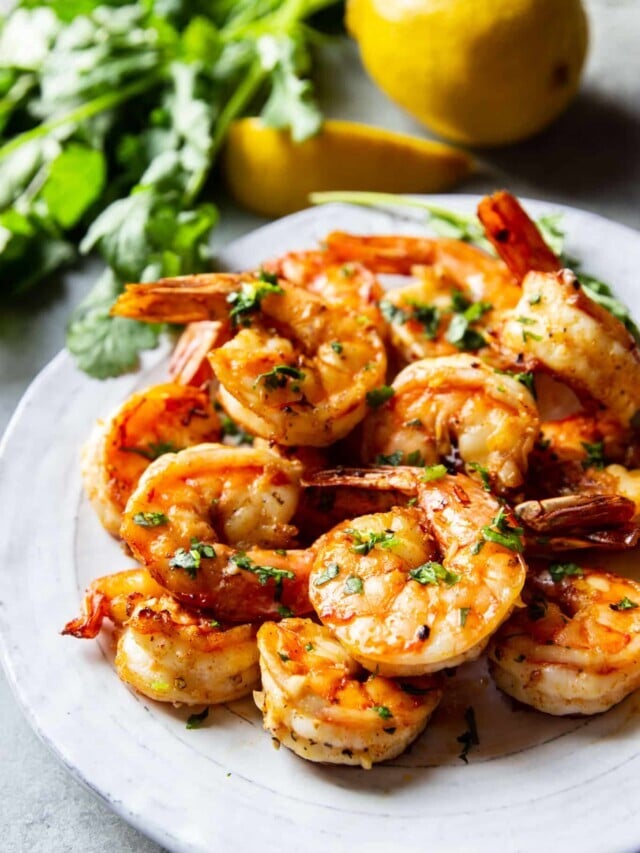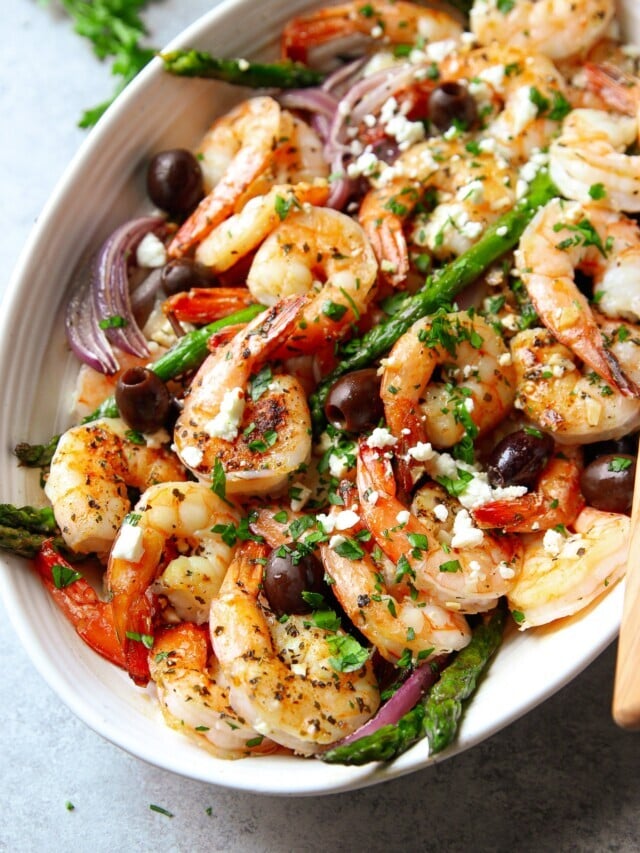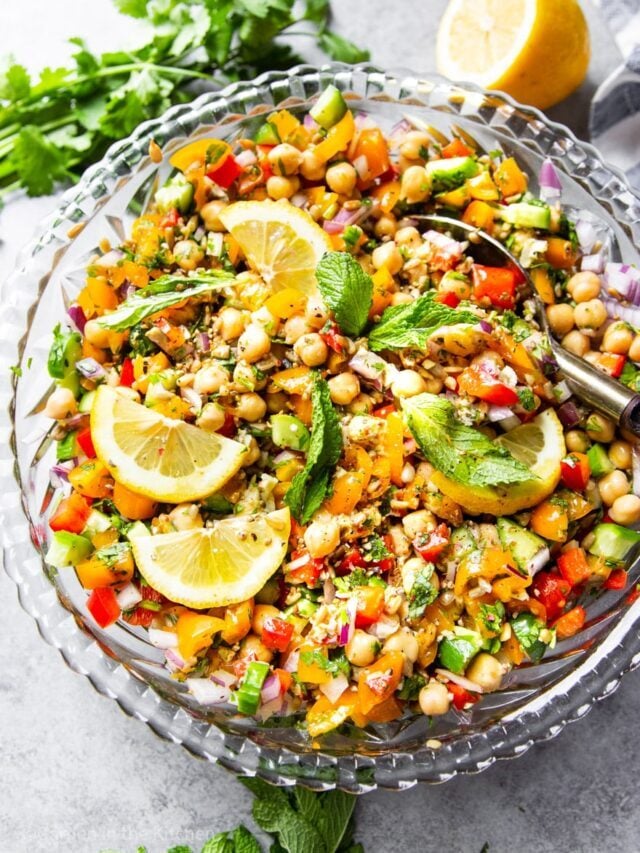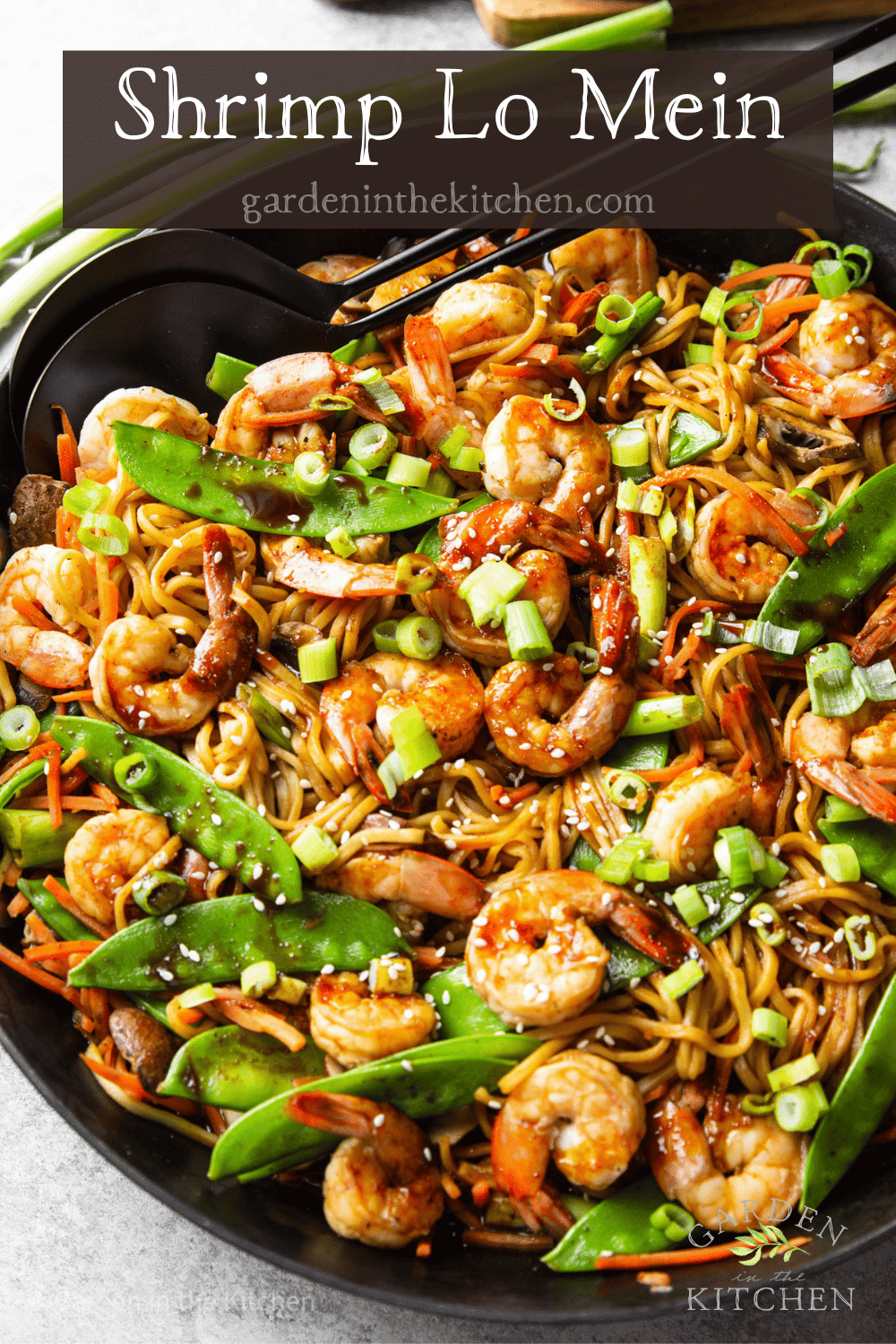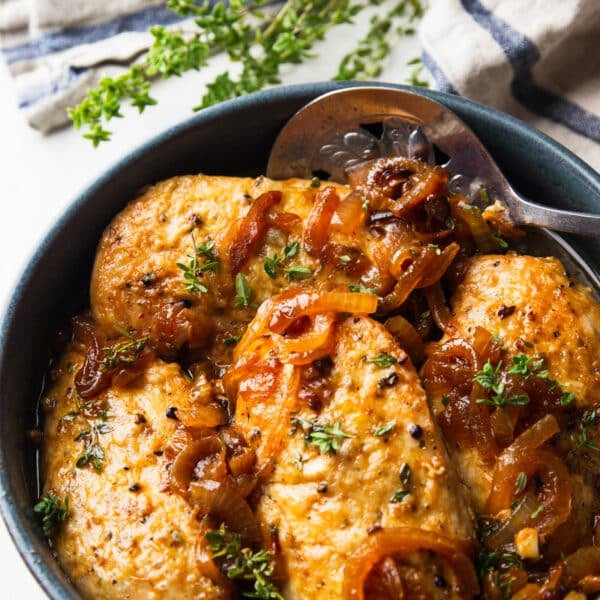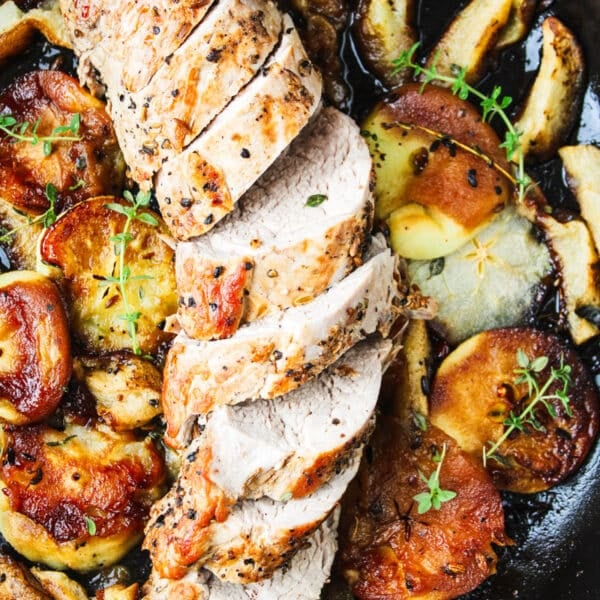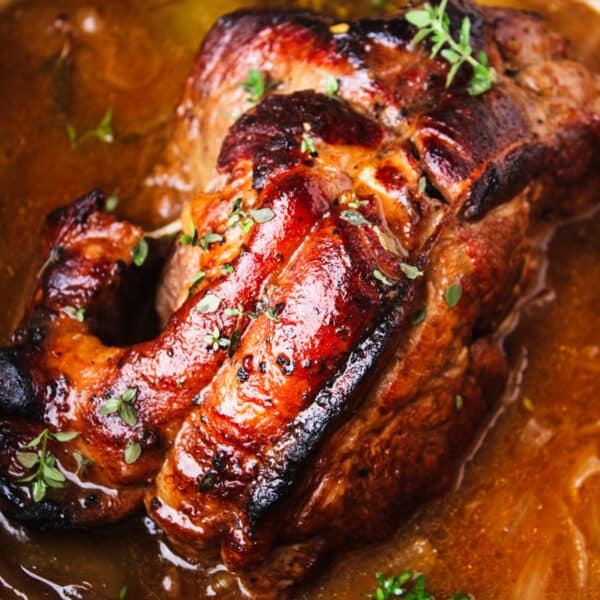This 30-minute Shrimp Lo Mein Recipe is a simplified version of everyone’s favorite Chinese noodle dish. Featuring noodles, veggies, seared shrimp, and a 2-ingredient lo mein sauce, it has everything you’d expect from takeout, but better! Easy to make gluten free.
Craving even more takeout-inspired dishes? Pair this easy lo mein recipe with my Beef and Broccoli, Orange Chicken, and Garlic Fried Rice.
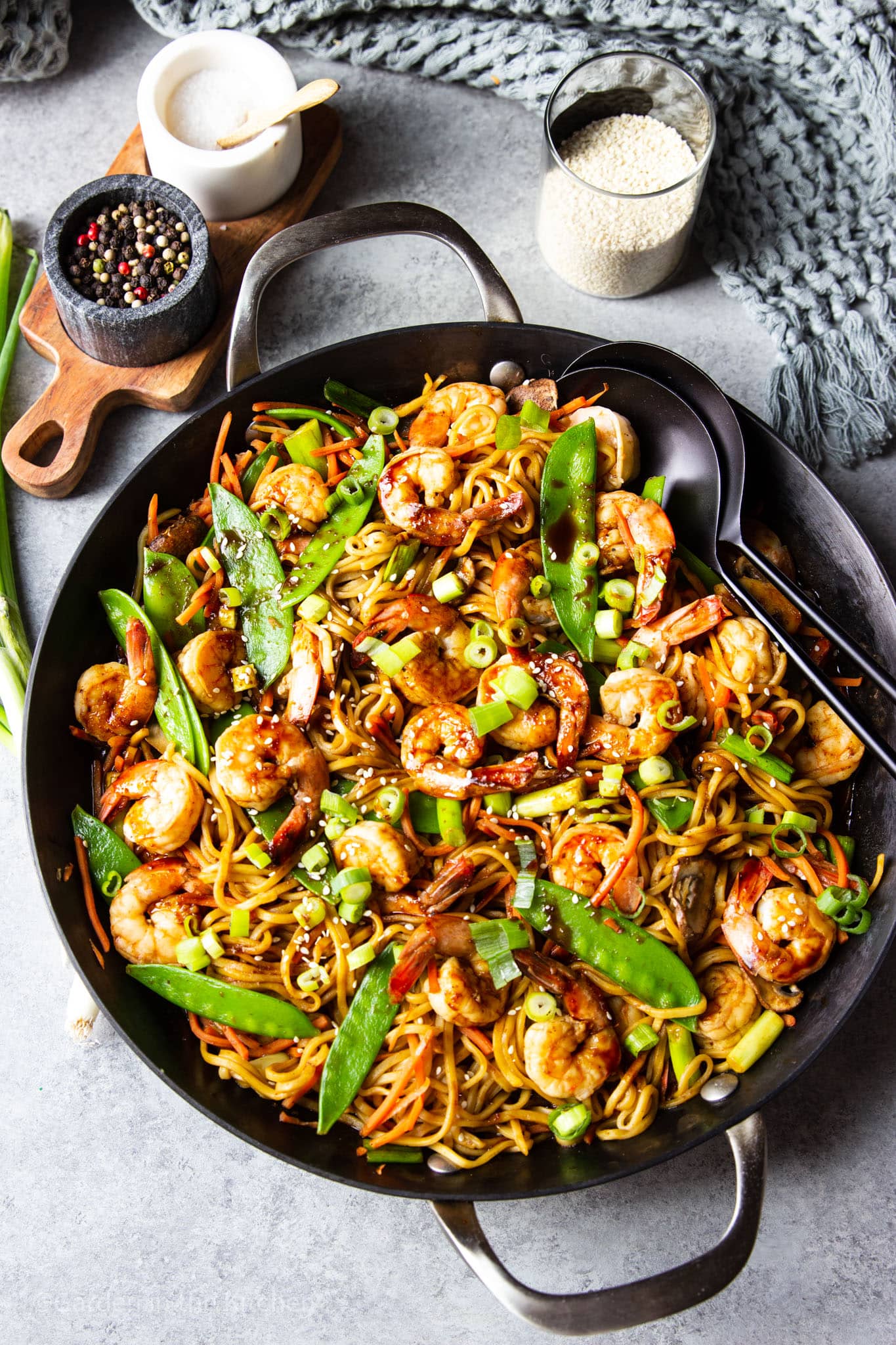
Table of Contents
Put down the takeout menu and make this super simple Shrimp Lo Mein Recipe instead! It’s a quick and inexpensive alternative to your favorite Chinese noodle dish with even bigger and better flavors. The step-by-step instructions guide you through making a family-size portion of this sweet, savory, and saucy meal in just 30 minutes.
Lo mein vs. chow mein
Lo mein and chow mein are two very similar dishes. They’re both made with Chinese egg noodles, a combination of veggies, meat, and seafood, and a delicate, flavorful sauce. The difference, however, is in how the noodles, mix-ins, and sauce come together.
In short, chow mein (chāu-mèn) are “stir-fried” noodles, meaning they’re fried in a pan with the rest of the ingredients. Lo mein (lāo miàn) is more low-maintenance. The noodles are simply stirred with the sauce, vegetables, and protein in the pan, then served.
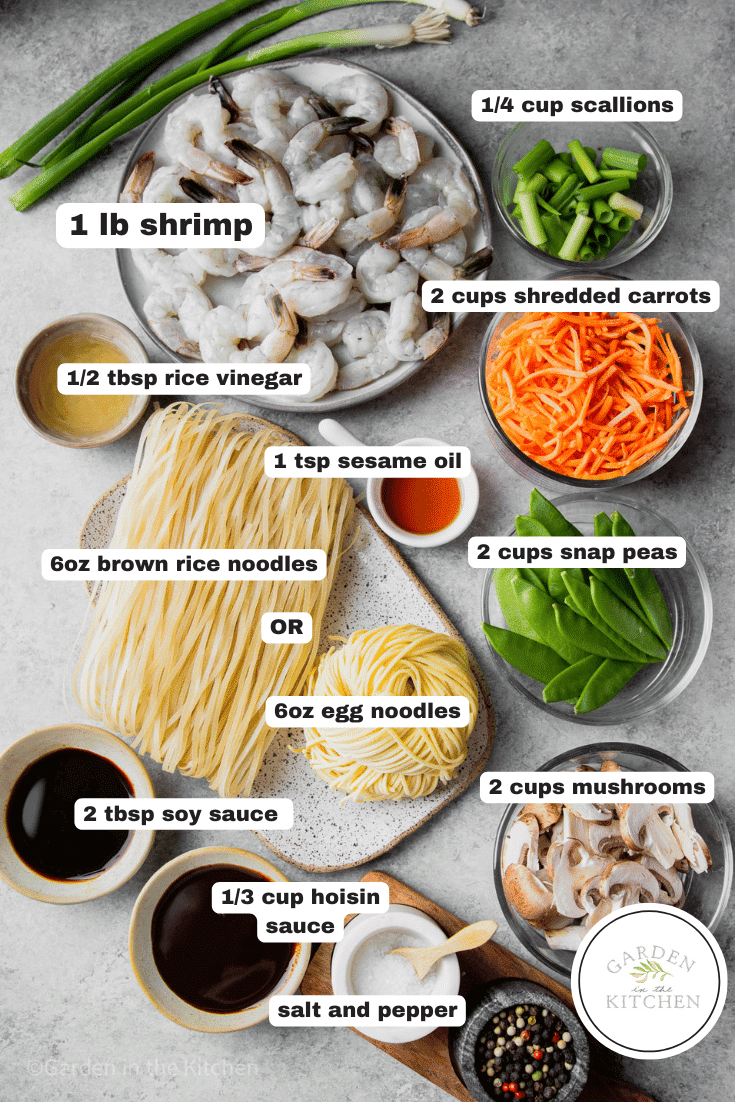
What kind of noodles are best for lo mein?
For the most authentic shrimp lo mein, fresh Chinese egg noodles (wheat noodles made with egg) are the best. They’re rich and flavorful, and don’t take much time to become tender and chewy when cooked.
I like using gluten free brown rice to keep the dish gluten free. You can easily make this with the gluten free noodles of your choice (find some ideas in the Ingredients below) or with regular egg, rice, or long pasta noodles if you don’t need them to be gluten free.
Ingredients and substitutions
- Shrimp – Use medium to large (about 30 to 40 per pound) fresh or frozen peeled and deveined shrimp. Whether or not you leave the tails attached is up to you. If you’re using frozen shrimp, just remember to thaw them in the fridge beforehand.
- Egg noodles – You can make this recipe with gluten free brown rice noodles or the more traditional egg noodles. If you can’t find egg noodles, feel free to use rice or soba noodles instead. Even long pasta noodles, like spaghetti or linguine, will work.
- Carrots – Shredded, for easy eating.
- Mushrooms – Use baby bella mushrooms or a variety of different kinds for a burst of umami flavor.
- Snap peas
- Scallions
- Coconut aminos – This is the first half of the lo mein sauce. You can also use tamari or soy sauce if you aren’t gluten free.
- Hoisin sauce – The other half of the lo mein sauce. This sweet and spicy Chinese condiment usually contains soybeans, sugar, water, spices, garlic, and chili. For gluten free lo mein, keep an eye on the hoisin sauce ingredients, as they’re not always gluten free.
- Sesame oil – A nutty-tasting oil that coats the shrimp and prevents them from sticking in the pan.
- Rice vinegar – This is also used to coat the shrimp. It’s tangy, but mild compared to other kinds of vinegar. If you don’t have rice vinegar at home, use apple cider vinegar or white wine vinegar instead.
- Salt and pepper
- Sesame seeds – For garnish, flavor, and crunch.

How to make shrimp lo mein
Step 1: First, peel and devein the shrimp (if needed) and rinse them under cold water. Pat dry, then season them with rice vinegar, sesame oil, salt, and pepper in a bowl. Set aside.
Step 2: Cook the noodles according to the package instructions. Immediately transfer them to a strainer using kitchen tongs. Don’t dump the pasta water because you’ll need it to boil the veggies in the next step.
Step 3: Bring the pot of pasta water back up to a boil. Add the veggies and cook until tender. Drain and set aside.
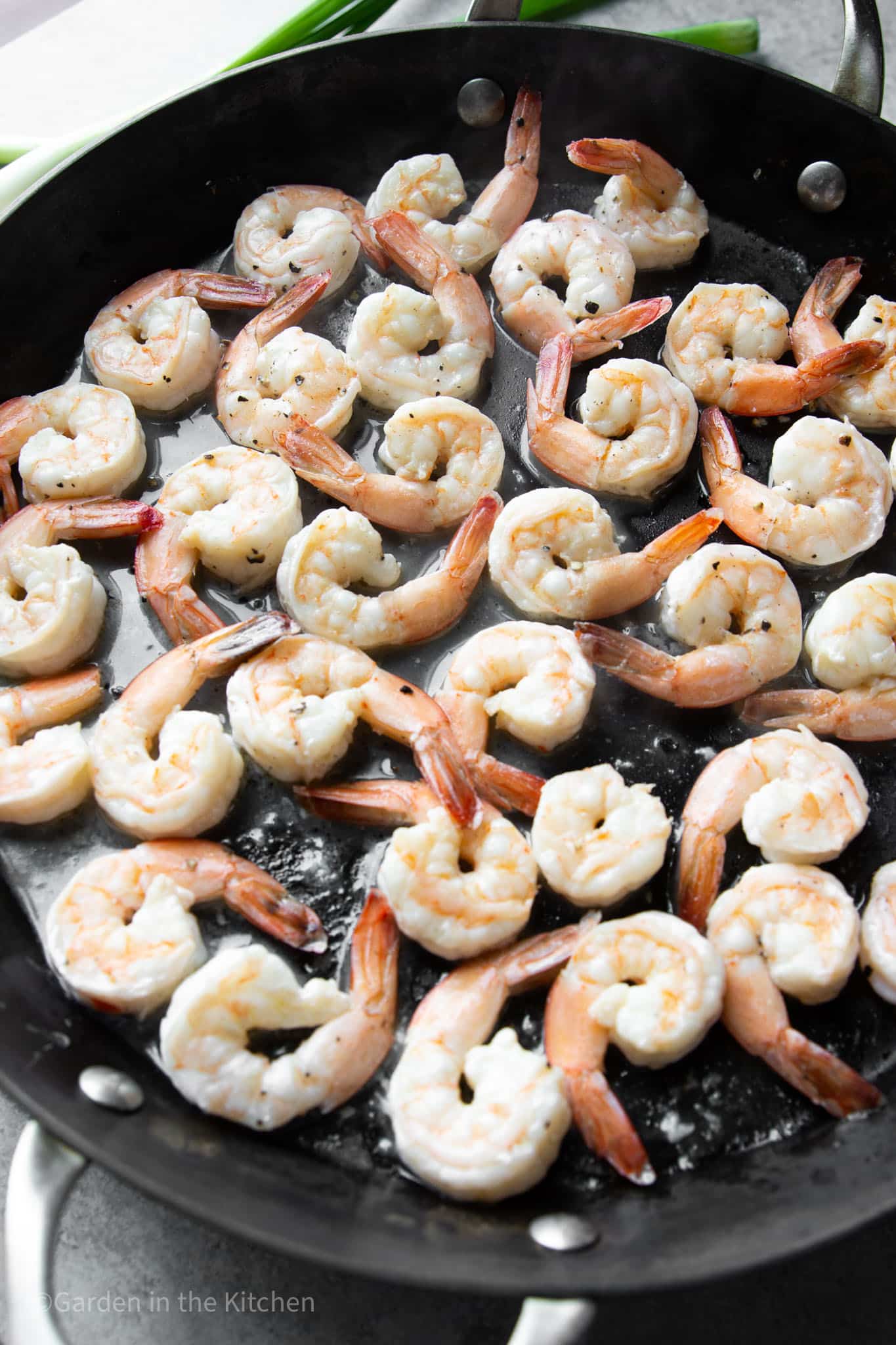
Step 4: Heat a wok or large skillet over medium-high heat. Once hot, add the seasoned shrimp and cook until it’s pink and opaque.
Step 5: Next, add the cooked noodles and veggies to the shrimp skillet. Pour the coconut aminos and hoisin sauce over top and toss to combine.
Step 6: Scoop the shrimp lo mein into bowls and garnish with fresh scallions and sesame seeds. Enjoy!

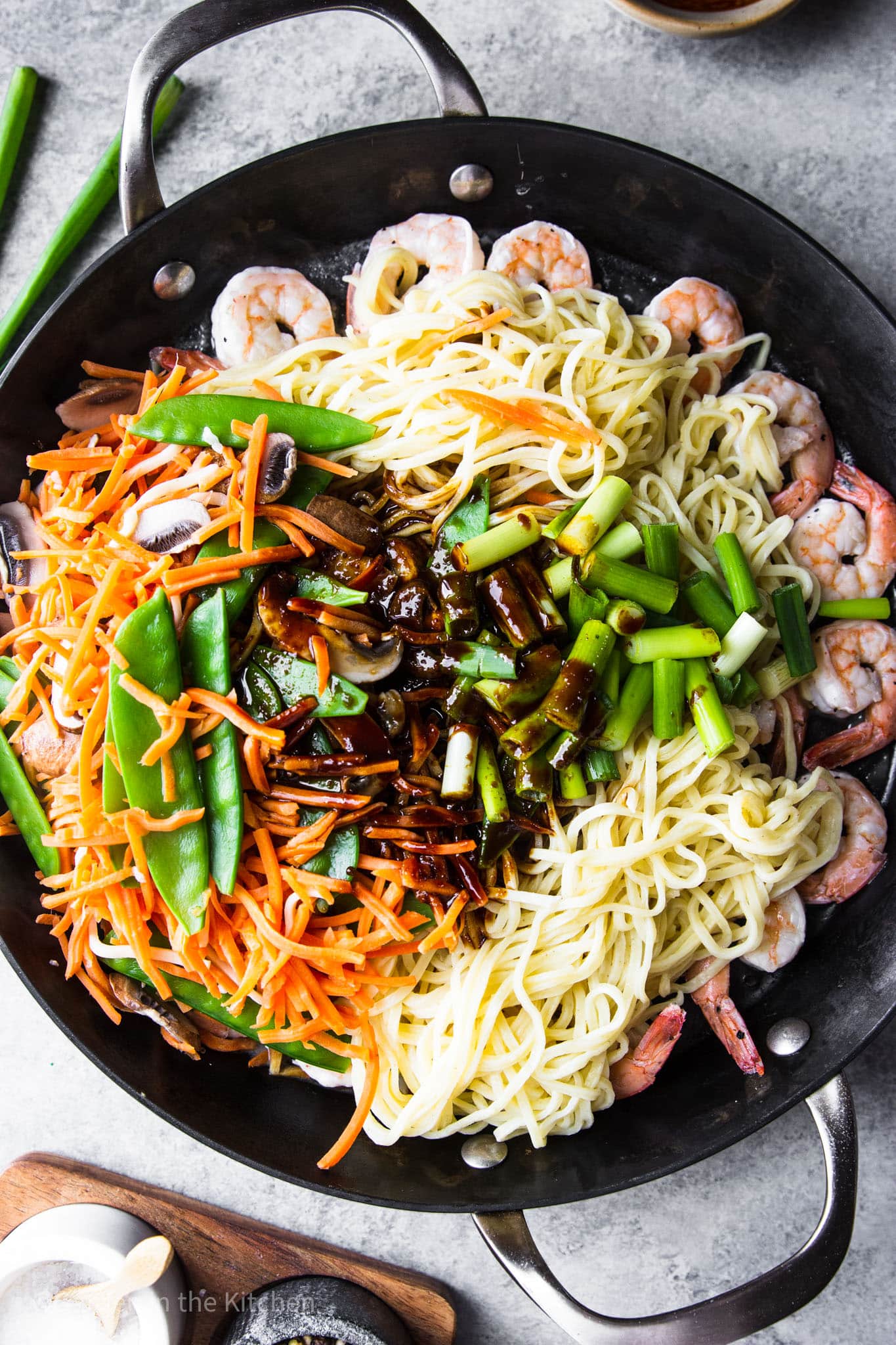
Tips and tricks
- Do not rinse the noodles after cooking because their surface starches help the lo mein sauce thicken and stick. The cooked noodles may start to clump together as they sit, so try to cook them right before assembly.
- Cut the vegetables into even, bite-sized pieces for quick cooking.
- You’ll know the vegetables are blanched to perfection when they’re tender but still have a slightly firm bite.
Variations
Here are some of the ways you can customize the flavors and ingredients in your homemade lo mein:
- Protein – Swap the shrimp for chicken, beef, or pork, or use some of each! If you’re vegetarian or vegan, use pan-fried tofu or tempeh. You can also stir in scrambled eggs.
- Vegetables – Besides carrots, mushrooms, and snap peas, bulk up the dish with broccoli, bell peppers, celery, green beans, bok choy, water chestnuts, napa cabbage, or baby corn.
- Flavor enhancers – Have fun with them! Add dried chilies, sriracha, or red pepper flakes to the lo mein sauce for spice. To elevate the flavors, sear the shrimp in the pan with aromatics, like green onion, garlic, and ginger.
Frequently asked questions
No. The purpose of a wok’s tall, steep sides is to keep the food inside of the wok while stir-frying. A large, heavy-bottomed skillet works just as well.
Sure! Air frying the shrimp is a great way to save extra time by multitasking. Once finished, toss the shrimp in a bowl with freshly cooked lo mein noodles, blanched veggies, and sauces.
Yes, most of the elements can be prepped ahead. Chop the vegetables, peel and devein the shrimp, and whisk the lo mein sauce ingredients the night before cooking. Keep everything in separate airtight containers in the fridge.
This way, all you need to do is sear the shrimp, boil the noodles and veggies, and throw it all together the next day.
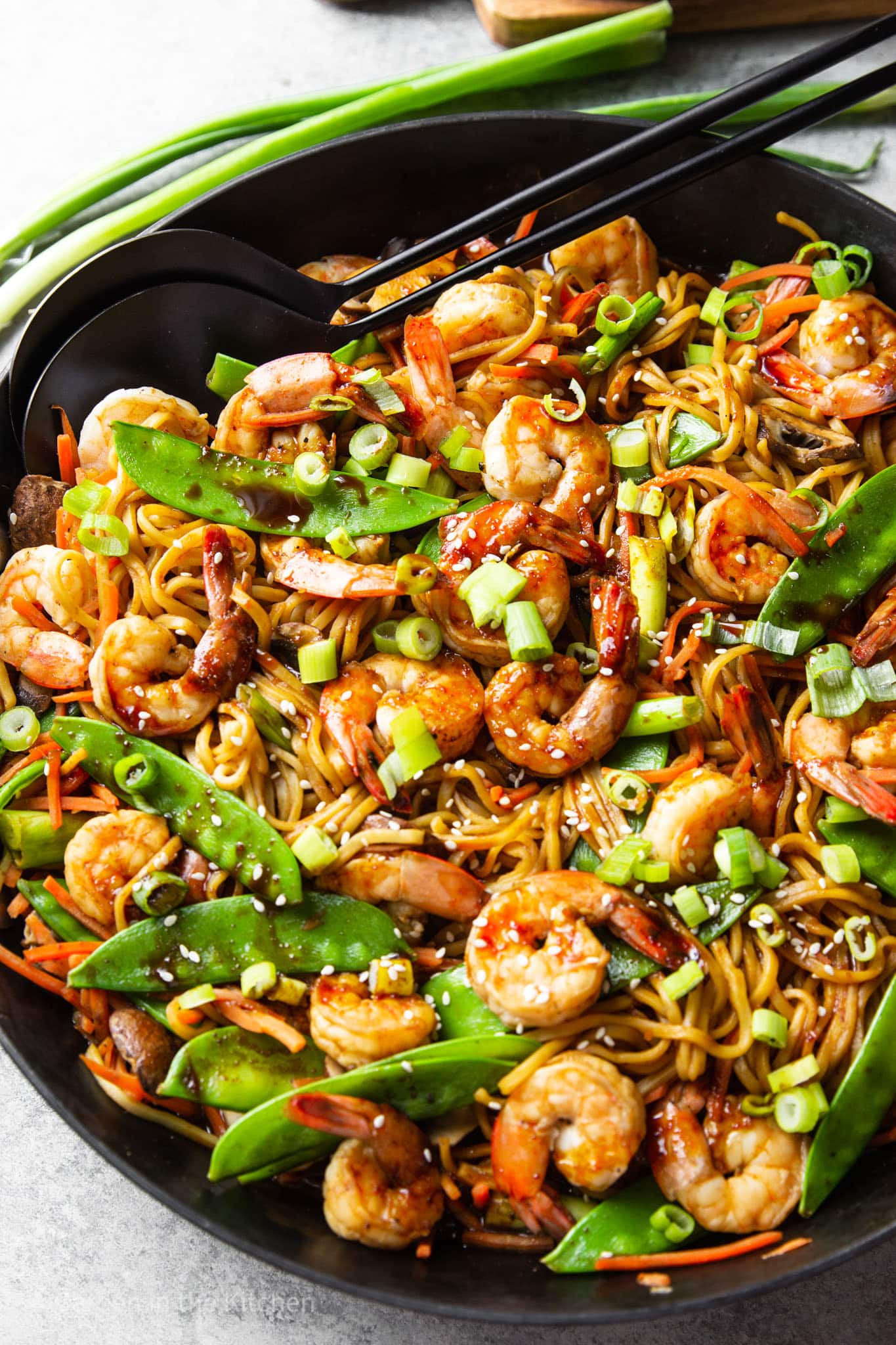
Storing
To store: Refrigerate the lo mein in an airtight container for up to 3 days. It makes for great leftovers!
To reheat: Warm the leftovers in the microwave or a pan on the stove until warmed through. Add a splash of water to help loosen the sauce.
Hungry for more easy copycat takeout recipes?
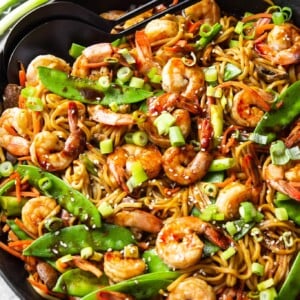
Shrimp Lo Mein Recipe
Ingredients
- 1 lb shrimp
- 6 oz egg noodles brown rice noodles (GF)
- 2 cups shredded carrots
- 2 cups baby Bella mushrooms sliced
- 2 cups snap peas
- 1/4 cup scallions
- 2 tbsp coconut aminos or soy sauce
- 1/3 cup hoisin sauce
- 1 tsp sesame oil
- 1/2 tbsp rice vinegar
- salt and pepper
- sesame seeds
Instructions
- Rinse shrimp and pat dry with paper towel. Season with salt, pepper, sesame oil and rice vinegar. Set aside
- Cook noodles according to package instructions. Transfer noodles to a strainer using kitchen tongs, keep the water in the pot to cook the vegetables.
- Cook the vegetables for 5 minutes in noodles water. Drain and reserve.
- Heat a wok or large cast iron skillet, when the skillet is hot add in the seasoned shrimp and cook for about 3 minutes, then turn shrimp over and cook for an additional 3 minutes.
- Transfer noodles and vegetables to shrimp skillet. Pour in sauces (coconut amigos or soy and hoisin sauce). Toss to combine. Add in fresh scallions and sesame seeds (optional) and serve.
Notes
- Do not rinse the noodles after cooking because their surface starches help the lo mein sauce thicken and stick. The cooked noodles may start to clump together as they sit, so try to cook them right before assembly.
- Cut the vegetables into even, bite-sized pieces for quick cooking.
- You’ll know the vegetables are blanched to perfection when they’re tender but still have a slightly firm bite.
Nutrition
Nutrition information is automatically calculated, so should only be used as an approximation.
